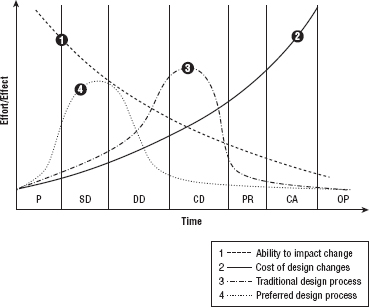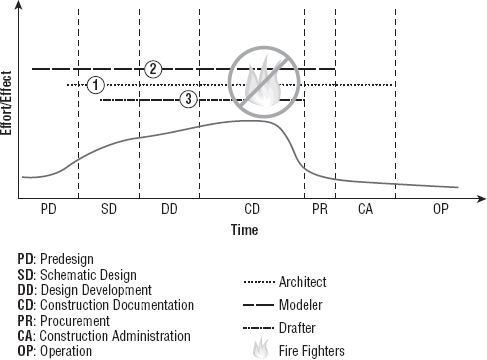Staffing for BIM
As you rethink the process of design and documentation, one of the fundamental changes you will need to address is staffing. A common misconception of project management when teams are first moving from CAD to BIM is that staffing the project will be the same in both workflows. This couldn't be further from the truth. When the workflow changes, staffing allocations, the time to complete tasks, and the percentage of work by phase are all affected as a result of the changes.
Several years ago, Patrick MacLeamy, FAIA, set out to illustrate the fundamental benefit to more informed design that happens to be a byproduct of building information modeling. The graph, which has come to be known as the MacLeamy Curve (Figure 5.7), is not intended to imply a simple shift in labor earlier in the design process; rather it stresses the importance of being able to make higher-value decisions before it becomes too difficult to make changes to a design. The X axis of the chart represents project phases from conceptual design through occupancy, whereas the Y axis represents the amount of effort in each phase.

Another way to think about this shift is as a diagram of leverage, as shown in Figure 5.8. Implementing BIM in earlier phases of a project gives you the greatest opportunity to add value to the overall compilation of building information delivered for a facility. When you begin BIM earlier, you may need to increase staff to build a better model or to perform energy analysis or preliminary quantity takeoffs; however, using a better tool like Revit will not necessarily translate to the same labor used in a CAD-based project. You will find how this affects your team effort after a few BIM projects.
FIGURE 5.8 BIM provides the most leverage when it is implemented earlier in the design.

Project Roles Using Revit
With such a significant change in the effort behind a BIM-based project flow, it's also important to understand how this change affects the various roles and responsibilities for the project team. Project managers need to be able to predict staffing and time to complete tasks throughout the project phases and have relied on past precedent of staff and project types to do this. Since a BIM-based project can significantly alter the project workflow, many of the historic timetables for task completion are no longer valid. However, a BIM-based project can be broken down into a few primary roles that will allow you some level of predictability through the various project phases. Although the specific effort and staffing will vary between offices (and even projects), there are some general roles that will need to be accounted for on every project.
There are three primary roles on every BIM project:
Architect Deals with design issues, code compliances, clear widths, wall types, and so on
Modeler Creates content in 2D or in 3D
Drafter Deals with annotations, sheet layout, view creation, and detail creation
These roles represent efforts and general tasks that you need to take into account on any Revit project. On a large project, these roles could also represent individual people, whereas on a smaller project they might be all the same person or one person might carry multiple roles. We'll now cover each of these in a bit more detail and discuss how these roles interact with the project cycle.
ARCHITECT
The role of the architect is to deal with the design and technical issues of the project. As the model is being created, you will naturally have to solve issues, like constructability and wall types; set corridor widths; deal with department areas; and deal with other issues involving either codes or the overall architectural design. This role will be the one applying standards to the project (as in wall types, keynotes, and so on) and organizing the document set. This role will need to be present on the project from the beginning to ensure consistency of the virtual building creation and isn't necessarily limited to only one person. This role also might or might not be a “designer.” Although it is possible to do early design in Revit, many project teams prefer to utilize other tools such as Google SketchUp or even pencil and trace paper. The job of the architect is steering the creation of the building within Revit. Tasks for this role include the following:
- Leading the creation of architectural elements and building from within the model
- Designing around code requirements and other building logistics
- Constructability and detailing aspects of the design
MODELER
The role of the modeler—in some firms referred to as the BIM coordinator—is to create and manage the 3D families and detail components needed in the project, which includes all the parametric families for things such as windows, doors, casework, wall types, stairs, railings, furnishings, and so on. Typically, this role is the responsibility of less experienced staff who might not be able to fulfill the role of architect. These roles tend to have longer periods of undisturbed time, making them better suited to deal with some of the longer, more involved tasks in modeling content. Finally, they also tend to have some 3D experience coming out of school. They might not have worked with Revit directly, but possibly with Autodesk 3ds Max or Google SketchUp, and are thereby familiar with working in a 3D environment. Tasks for this role include the following:
- Creating model content and families
- Creating drafting components
- Managing system families within the project
DRAFTER
The role of the drafter is to create sheets and views and embellish those views with annotations or other 2D content. This role will be doing the bulk of the work needed to document the project. In earlier stages of the project, this role is typically assumed by either the architect or the modeler, but as documentation gets moving into high gear, this can quickly become the role of multiple people on a larger project. Tasks for this role include the following:
Now let's apply these roles to the project timeline. It's important to understand how these roles can be best integrated into the typical project workflow. If you look at a typical project process, outlined in Figure 5.9, you see Time on the X axis and Effort on the Y axis. Superimposed on this chart is the curve that represents the effort in a BIM workflow demonstrating labor intensity at various times of the project cycle. We have also taken the roles of architect, modeler, and drafter and shown them in the graph represented by the numbers 1, 2, and 3, respectively.
FIGURE 5.9 Roles over the project cycle

From a work planning purpose, we are demonstrating the ideal times to bring in some of these various roles. At the inception of a project design, a modeling role will be of the best use. This person can help create building form, add conceptual content, and get the massing for the building established. If you're using the conceptual modeling tools (covered in Chapter 9, “Advanced Modeling and Massing”), the modeler can even do some early sustainable design calculations (covered in Chapter 10, “Conceptual Design and Sustainability”).
Once the project begins to take a more established form and you complete conceptual design, you'll need an architect role to step in the project. As in a typical project, you'll have to mold the form into building by applying materials, applying wall types, and validating spatial requirements and the owner's program.
During schematic design, you'll need to include the role of the drafter to begin laying out sheets and creating views. These sheets and views don't have to be for a construction document set as of yet, but you'll need to establish views for any schematic design submittals. If these views are set up properly, they can be reused later for design development and construction document submittals as the model continues to gain a greater level of detail.
You should avoid adding staff to your project during the construction documentation phase. In a BIM/Revit workflow, this can sometimes cause more problems than it solves and slow down the team rather than get work done faster.
Establishing a Work Plan
Another proven technique of managing larger Revit projects is to assign work according to elements of the building rather than by drawing series. For example, one person would be responsible for building enclosure, another for structure, interior partitions, furniture, vertical circulation, and so on. This strategy encourages each team member to develop their portion of the design more collaboratively as the modeling for each component must be coordinated with the surrounding systems.
Even though your team won't be assigned work through series of sheets, each person should be tasked with overseeing each sheet series. The annotation related to each building system is the responsibility of the respectively assigned team member, but someone else will be responsible for reviewing each series of sheets to ensure that they are appropriately maintained for presentation or distribution. On smaller projects, the project architect would likely be the person supervising the entire sheet set.
This dual responsibility is an important aspect of team management that will keep your BIM projects on track. Spending the majority of time working in the model and thus neglecting the preparation of properly annotated sheet views becomes very alluring.
Adding Team Members to Fight Fires
In many projects, there might come a time when the schedule gets tight and the project management wants to add more staff to a project to meet a specific deadline. When in a 2D CAD environment, new team members would be added to help meet a deadline and would have the burden of trying to learn the architecture of the building, the thoughts behind its design, and how its various systems interact. In a Revit project, they have that same obligation, but they have the additional task of learning how the model has been configured. The model will have constraints set against various elements (such as locking a corridor width) and various digital construction issues (such as how floors and walls might be tied together or what the various family names are, or workset organization). New team members can need additional time to “ramp up.”
Regardless of planning, deadlines still escape the best of architects and project managers. It's a good idea to know when and how you can “staff up” to be sure to meet those deadlines. Keeping in mind that your team members new to the project have to learn about both the design and the model, here are some task ideas to both help production and make sure they don't accidentally break anything:
Content Creation You will find that you will be making model families or detail components until the end of the project. This will help get the new team members engaged in a specific part of the project and also isolate them enough until they learn a bit more about how the model has been configured.
The Drafting Role Even if this isn't their ultimate role, having new team members help create views and lay out sheets will get them familiar with the architecture while still allowing the team to keep progressing on the document set.
Working on Detailing Every project can always use someone who knows how to put a building together. If you have someone new to the project and possibly even new to Revit, let them embellish some of the views already created and laid out on sheets with 2D components, linework, and annotations.
